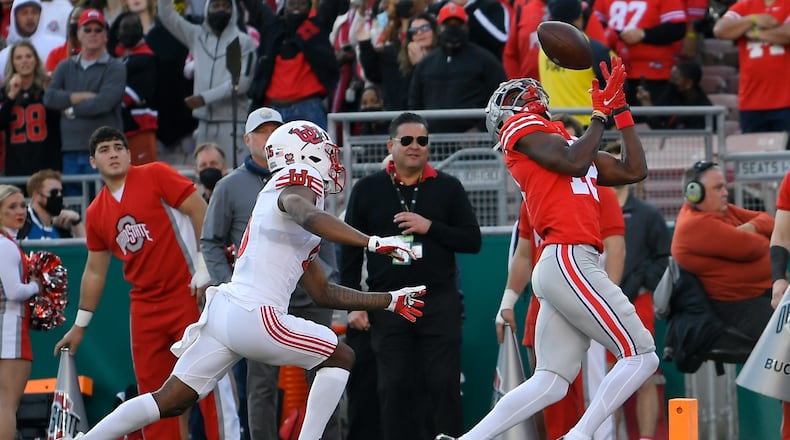Every season has questions, though, and these are the top four entering the preseason:
1. How will playing time shake out between tight ends and receivers?
The receiving room is full of talent but not so much experience.
Brian Hartline has 11 players who were four- or five-star recruits, but Jaxon Smith-Njigba, Julian Fleming and Kamryn Babb are the only ones who graduated from high school before 2021, and the latter two often have been sidelined by injuries since arriving in Columbus.
With sophomores Emeka Egbuk and Marvin Harrison Jr. having looked good in cameos last year, there is little doubt Hartline can make it work, but it remains to be seen how deep he will be willing to go in the lineup regularly.
Into the breach could step the tight ends.
This is also a group that could use more experience, but Kevin Wilson has a lot of bodies to choose from (and he only needs a rotation of two or three to be considered “deep”).
Tight end is a pivotal position in the Ohio State offense because ideally the No. 1 guy will be able to thrive both as a blocker and a pass catcher, giving the coaching staff more flexibility when it comes to play-calling. Having a second player who can also be comfortable blocking and win matchups in pass patterns exponentially expands the playbook, but developing a No. 2 tight end who is more of a threat than the No. 3 receiver is no easy task given the way the Buckeyes have recruited at the latter in recent years.
Of course, Ohio State can be expected to play plenty of three-receiver sets (“11 personnel”) and two-tight end looks (“12 personnel”), but the mix will be interesting to watch as the season goes on.
2. Will a more traditional lineup help the offensive line?
Ohio State had a good, not great offensive line last season.
Concluding it was worse than it really was is not hard to do, though, because the two biggest negatives for the group happen to be the last two areas most Buckeye fans want to see their team struggle: Run blocking and the Michigan game.
The Wolverines’ elite pass rushers being able to feast on the OSU front was certainly a credit to Michigan, but the Buckeyes did themselves few favors by becoming predictable as the season wore on.
The running game was limited largely to big plays while being unreliable in short-yardage, making game-planning for Ohio State easier.
Some of that was a freshmen running backs learning the ropes, but there also appeared to be times putting four long, athletic linemen on the field with center Luke Wypler made getting leverage inside more difficult (however much it helped in pass protection).
Senior guard Matt Jones is built more like a fire hydrant than a basketball player, and pairing him with sophomore Donovan Jackson — who has the athleticism to play tackle in a pinch but is a natural guard built lower to the ground — could make a positive difference.
3. How good can C.J. Stroud be?
Sometimes this question is asked in regard to whether or not a quarterback’s ceiling could hold back his team. That is not the case here.
Stroud wasn’t perfect in his first season as a starter, but it says something about the expectations for the position in recent seasons that his few mistakes were put under such a microscope even in his first few starts.
He grew as the season went on and has the arm strength and touch to make any throw. The more defenses he sees, the more he seems to learn, and he has demonstrated a great ability to read what he is seeing and react quickly even with only a baker’s dozen starts under his belt.
A quarterback who can always find the open and and deliver the ball anywhere on the field is the hardest thing to stop in the game, and Ohio State should have that this fall if Stroud remains on the trajectory he was as a redshirt freshman.
4. Will Ryan Day learn from his mistakes?
While no one questions Day’s offensive knowledge or ability to coach quarterbacks, his offense bogged down last season when it became too pass-heavy (with the exception of the Rose Bowl, a game in which Utah was severely limited personnel-wise in the secondary).
That was largely a function of teams knowing when to gear up to stop the run and when to put more resources towards slowing the passing game — in particular by taking away the deep ball.
Despite talking about wanting to have more balance, Day didn’t seem to trust the running game in big spots late in the season, and some struggles earlier in the campaign made that justifiable. However, he might have been served by being more stubborn with it earlier in the year to build confidence both in his players and his play-calling.
About the Author

